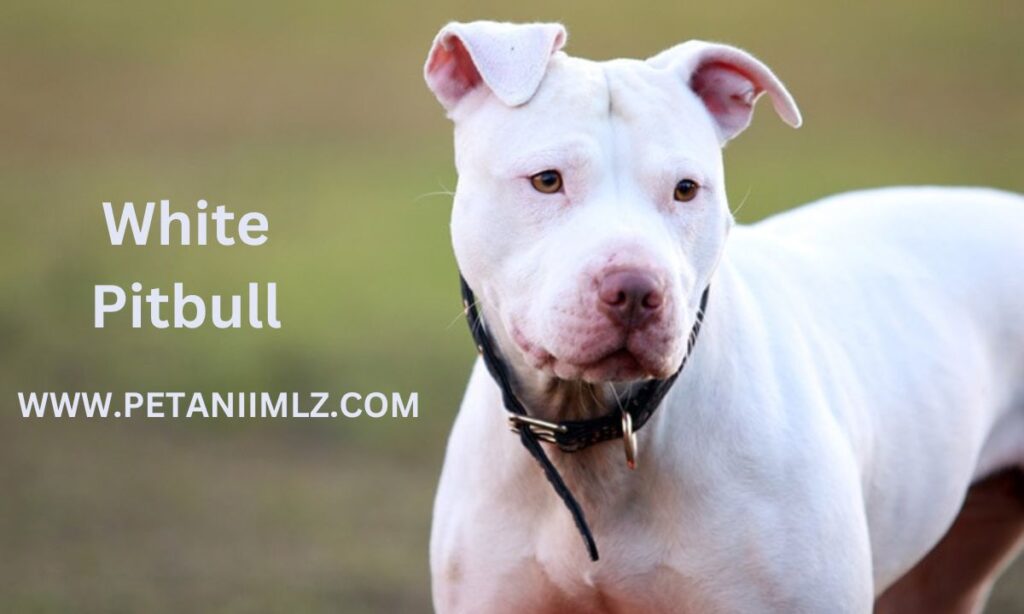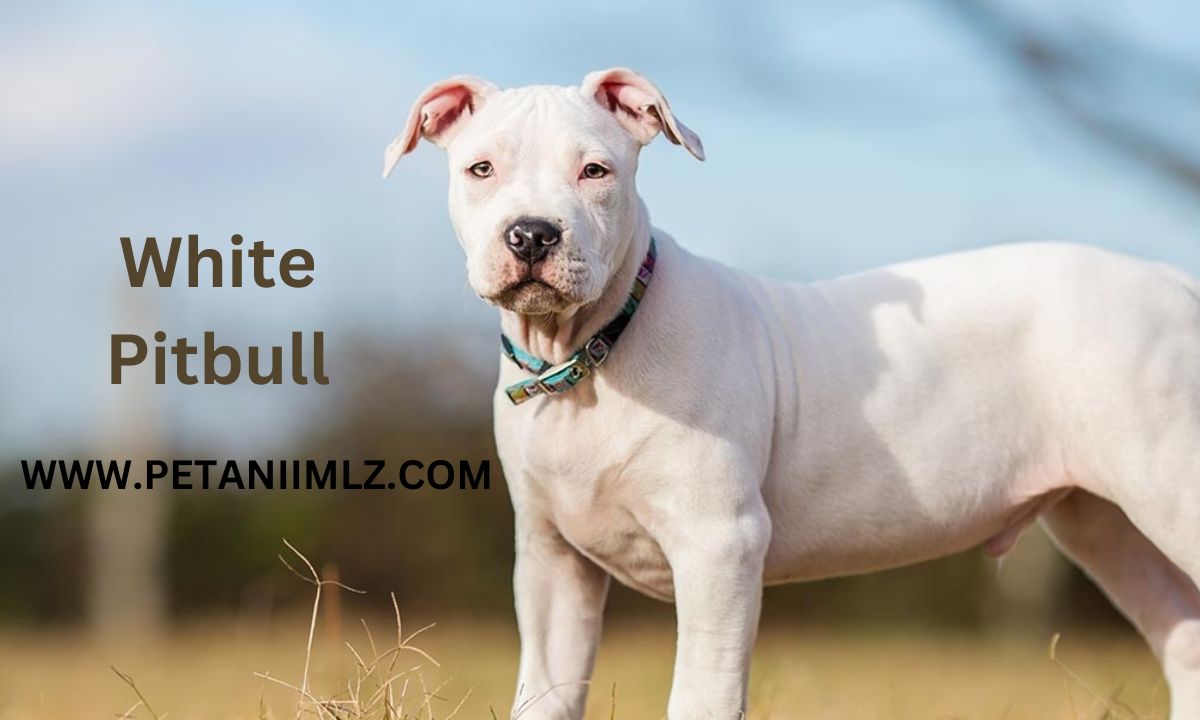White Pitbull: Complete Guide
Introduction
In this article, complete information about White Pitbull is given. Ever seen a white pitbull and wondered what makes it so unique? You’re not alone. In this comprehensive guide, we’ll dive into the fascinating world of white pitbulls. From their intriguing history and eye-catching physical traits to their lovable personalities and health considerations, we’ve got it all covered. So, let’s get started!
History and Origin of White Pitbull
- Brief history of the pitbull breed: Pitbulls originated from a mix of bulldogs and terriers, bred initially for bull-baiting and later as farm dogs.
- How white pitbulls came into existence: The white coat in pitbulls is a result of selective breeding and sometimes, natural genetic mutations.
- Genetic factors contributing to their white coat: The white coat is often due to a lack of pigmentation, controlled by a series of genes.
White Red Nose Pitbull Genetics
When it comes to understanding the unique appearance of a White Red Nose Pitbull, it’s essential to delve into the world of canine genetics. These dogs are not only known for their distinctive red nose but also for their white coat, which is a result of specific genetic factors. In this article, we will explore the genetics behind the White Red Nose Pitbull and differentiate between Leucism and Albinism.

Genetic Factors Influencing Coat Color
- E Locus (Extension Locus): This gene determines the presence of eumelanin, which is responsible for black or brown pigmentation. A recessive ‘e’ allele can result in a lighter coat.
- S Locus (Spotting Locus): This gene is responsible for the distribution of white patches or spots on the coat. A dog with two recessive ‘s’ alleles will have a predominantly white coat.
- D Locus (Dilution Locus): This gene dilutes the color of both eumelanin and pheomelanin, leading to lighter shades like blue or fawn.
- MC1R Gene: This is the gene responsible for the red nose in Pitbulls. A mutation in this gene can result in a red nose instead of the more common black nose.
Leucism vs. Albinism – What’s the Difference?
Leucism
- Partial Loss of Pigmentation: Leucism is characterized by the partial loss of pigmentation, affecting not just the coat but also the skin and eyes to some extent.
- Genetic Mutation: It is caused by a genetic mutation that affects multiple types of pigment, not just melanin.
- Eye Color: Unlike albinism, leucism does not necessarily result in red or pink eyes. The eye color can vary.
Albinism
- Complete Loss of Pigmentation: Albinism is a complete lack of melanin, affecting the coat, skin, and eyes.
- Specific Gene: Albinism is caused by a mutation in a specific gene known as the TYR gene.
- Eye Color: Albinism often results in red or pink eyes due to the lack of pigmentation.
White Red Nose Pitbull Temperament
- Friendly and Affectionate: Contrary to popular belief, the White Red Nose Pitbull is generally a friendly and affectionate dog, especially towards its family.
- Intelligent and Trainable: These dogs are highly intelligent and respond well to positive reinforcement training methods.
- Energetic: They are energetic dogs that require regular exercise to keep them happy and healthy.
- Loyal: One of the defining characteristics of this breed is its loyalty to its family.
Physical Characteristics
- Coat color and texture: White pitbulls have a smooth, short coat that’s, well, white! But shades can vary from pure white to cream.
- Eye color variations: Their eyes can be brown, blue, or even one of each!
- Size and build: Generally, they weigh between 30-70 pounds and have a muscular build.
- Lifespan: With proper care, a white pitbull can live up to 12-14 years.
Personality Traits
- Common misconceptions: Many people think white pitbulls are aggressive, which is far from the truth.
- Actual temperament: These dogs are loyal, friendly, and energetic.
- Good with families and other pets: Contrary to popular belief, they’re excellent family pets and get along well with other animals.
Health Concerns
White Red Nose Pitbull Lifespan and Potential Health Issues
- Lifespan: Generally, the lifespan of a White Red Nose Pitbull ranges from 12 to 16 years.
- Hip Dysplasia: This breed is prone to hip dysplasia, a genetic condition that affects the hip joint.
- Skin Issues: Due to their white coat, they may be more susceptible to skin issues like allergies and sunburn.
- Genetic predispositions: White pitbulls are more prone to skin conditions due to their lack of pigmentation.
- Common health issues: These include skin conditions like dermatitis and a higher likelihood of deafness.
- Importance of regular vet check-ups: To keep your white pitbull healthy, regular vet visits are a must.
Food and Diet
- High-Quality Kibble: A balanced diet of high-quality kibble is generally recommended.
- Protein-Rich: Make sure the food is rich in proteins to support their energetic lifestyle.
- Avoid Human Food: Foods like chocolate, grapes, and onions are toxic to dogs and should be avoided.
Grooming and Shedding
- Low Shedding: The White Red Nose Pitbull is a low-shedding breed.
- Regular Baths: Due to their susceptibility to skin issues, regular baths with dog-specific shampoo are recommended.
- Nail Trimming: Regular nail trimming is also essential for their well-being.
Are White Red Nose Pitbulls Dangerous?
- Misconception: The breed is often misunderstood and labeled as dangerous due to negative media portrayal.
- Training and Socialization: With proper training and socialization, they make excellent family pets.
White Red Nose Pitbulls Pros and Cons
Pros:
- Friendly and Loyal: They are extremely friendly and loyal to their families.
- Low Maintenance: They are relatively low maintenance in terms of grooming.
- Intelligent and Trainable: Their intelligence makes them highly trainable.
Cons:
- Exercise Needs: They require a lot of exercise, which may not be suitable for everyone.
- Potential Health Issues: They are prone to certain health issues like hip dysplasia and skin problems.
- Public Perception: Due to negative media portrayal, they are often misunderstood, which can lead to issues like housing restrictions.
Care and Maintenance
- Diet and Nutrition: A balanced diet is crucial for your white pitbull. Opt for high-quality dog food rich in protein and low in fillers.
- Exercise Needs: These dogs are energetic and need at least an hour of exercise daily. Activities can range from walks to fetch games.
- Grooming Tips: Their short coat is relatively easy to maintain. A weekly brush and occasional baths will do the trick.
Training and Socialization
- Importance of Early Socialization: The earlier you socialize your white pitbull, the better. Exposure to different environments and people is crucial.
- Training Tips and Techniques: Positive reinforcement works best. Use treats and praises to encourage good behavior.
- Behavioral Issues to Watch Out For: Some may develop separation anxiety or excessive barking if not properly trained.
FAQs
· Are white pitbulls rare?:
- They are less common than other colors but not extremely rare.
· Do white pitbulls have more health issues?:
- They are prone to skin issues and deafness but are generally as healthy as pitbulls of other colors.
· Are white pitbulls aggressive?:
- No, they are not inherently aggressive. Their temperament is similar to pitbulls of other colors.
· How do I adopt a white pitbull?:
- Check local shelters, rescue groups, or reputable breeders. Always opt for adoption when possible.
· How rare is a white pitbull?
- White pitbulls are less common than other colors, but they are not extremely rare. Their white coat is a result of specific genetic factors, but they can be found in shelters, rescue organizations, and from reputable breeders.
· What is the most expensive pitbull color?
- The most expensive pitbull color can vary depending on trends and demand. However, “blue” pitbulls, which have a unique grayish coat, are often considered more expensive due to their rarity and unique appearance.
· What is the difference between a white pitbull and a Dogo Argentino?
- While both may have a similar white coat, they are different breeds with distinct histories and characteristics. Dogo Argentinos are larger, originally bred for big-game hunting in Argentina, and have a more robust build. White pitbulls are generally smaller and have a more varied background, including being bred for companionship.
· Which color is rare in pitbull?
- Merle-colored pitbulls are considered rare. This coat pattern features patches of diluted pigment and is not commonly seen in pitbulls. However, it’s essential to note that merle pitbulls can have health issues related to their unique genetics.
· What is the strongest dog in the world?
- The term “strongest” can be subjective and depends on what you mean by strength—physical power, endurance, or protective instinct. Breeds like the Mastiff, Saint Bernard, and Alaskan Malamute are often cited as physically strong dogs.
· Which is the strongest dog breed?
- Again, “strongest” can be subjective. If you’re talking about bite force, the Kangal is often cited as having one of the strongest bites. If you mean endurance, breeds like the Alaskan Malamute and Siberian Husky are incredibly resilient.
· Which type of pitbull is best?
- The “best” type of pitbull depends on what you’re looking for in a dog. American Pit Bull Terriers are known for their loyalty and friendliness. American Staffordshire Terriers are often cited for their good nature with children. It’s essential to meet individual dogs to determine which is best for you.
· Which dog is best pitbull?
- The “best” pitbull is subjective and depends on your lifestyle, needs, and what you’re looking for in a companion. Generally, pitbulls are known for their loyalty, intelligence, and good nature.
· What is the cheapest pitbull?
- Pitbulls from shelters or rescue organizations are generally the least expensive option and come with the added benefit of giving a dog a second chance at a loving home.
· What 2 breeds make a pitbull?
- The term “Pit Bull” is often used to describe a type of dog rather than a specific breed. However, the American Pit Bull Terrier originated from a mix of bulldogs and various types of terriers.
· Are pitbulls good with kids?
- Pitbulls are often excellent with children, known for their loyalty and affectionate nature. However, like any dog breed, it’s crucial to supervise interactions between dogs and young children.
· Do white pitbulls go deaf?
- White pitbulls have a higher likelihood of being deaf due to the lack of pigmentation in their inner ears. However, not all white pitbulls will experience this, and many lead perfectly healthy lives.
Conclusion
In summary, white pitbulls are fascinating dogs with a rich history, unique physical characteristics, and lovable personalities. They make excellent family pets and are just as healthy as their colorful counterparts when properly cared for. If you’re considering adding a four-legged friend to your family, why not a white pitbull? Trust us; they’re pawsitively amazing!




